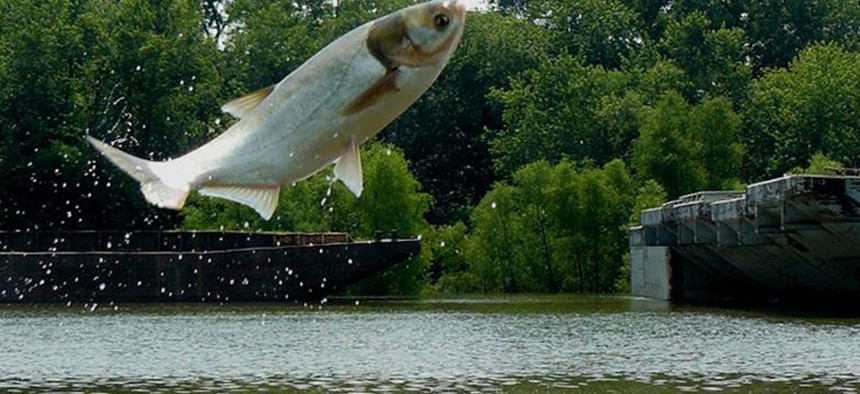Kentucky Hopes You’ll Eat Its Invasive Carp

Great Lakes Restoration Initiative
If you can’t beat ‘em, eat ‘em?
A new Asian carp processing plant will open in Hickman, Kentucky, Governor Steve Beshear announced last week. If the combination of Asian carp and Kentucky sounds decidedly strange to you, it should: The three species found in the state’s rivers and lakes are invasive, accidentally introduced into the wild by researchers and private citizens sometime in the 1980s. Since then, the fish have spread into over 20 states, disrupting local ecosystems and economies along the way.

The distribution of bighead and silver carp as of April 2013. ( U.S. Fish and Wildlife )
The problem: These are hungry, hungry fishes, capable of eating 5 to 20 percent of their body weight each day and quickly consuming exactly the food—plankton and algae—that native species also enjoy. Compounding the problem is the fact that they reproduce at a shocking clip, producing more than 1 million eggs per large adult per year. The carp have also been known to scare the crud out of—and even injure—recreational and professional fishermen; the easily-startled silver carp can leap 10 feet out of the water in response to the sound of boat motors, landing on boats and people and damaging equipment. Watch these suckers fly:
Which brings us back to Hickman and Riverine Fisheries International LLC, the company that will run the plant there. According to the local NBC affiliate , the operation will “catch, clean, process, package, and transport various species of Asian carp found in Kentucky’s waters.” The carp will eventually become imitation seafood, fishmeal, fish oil, mince, and fillets, and be shipped “to every major market in the world.” Chinese markets, in particular, have shown interest; the state’s other Asian carp plant has sent more than a half-million pounds of processed fish to China, where they are, as NPR reported last spring , “a prized food.”
But will Americans learn to love the taste of invading carp? Could we eat our way out of this ecological quandary? Kentucky is hoping so. The state’s Department of Fish & Wildlife's web page on carp includes a section on preparation and cooking, including a link to a YouTube video that pitches the fish as “Kentucky tuna.” To sweeten the deal, the department writes this: “[Bighead and silver carp] reportedly make good table fare for the person willing to remove the many bones and the undesirable strip of red meat along the sides.” Sold yet? The state has also hosted Carp Madness , a freshwater commercial fishing tournament that netted nearly 40 tons of Asian carp in 2013. Others have floated the idea of using carp in school lunches.
It may be that robust American carp market is appealing to economic development-minded folks, but ecologists are already looking beyond Kentucky, into the Great Lakes region . Scientists are hoping to keep the fish out of those northern waters because they're home to a number of endangered fish, plants, mammals, insects, and reptiles that would be threatened by the carp’s voracious eating habits. The federal government has given millions in funding to the Great Lakes Restoration Initiative to keep the Asian carp out, but Kentucky and the states surrounding it complain that the government has done little to help them out of their own fishy quagmire.
State officials say they’re hopeful about the Riverine Fisheries’ project. “We are excited that Riverine Fisheries will soon open in Kentucky," Ron Brooks, fisheries director with the Kentucky Department of Fish & Wildlife Resources, told the Kentucky NBC affiliate . "We look forward to Riverine Fisheries helping us with our efforts to save our native fish."





